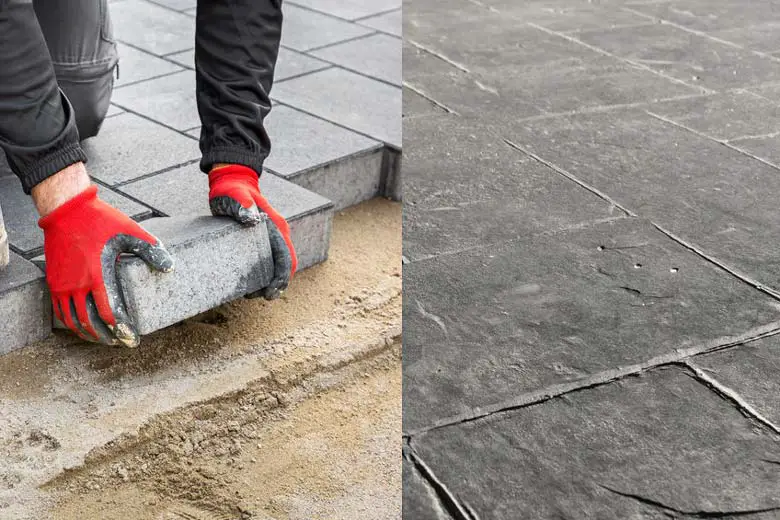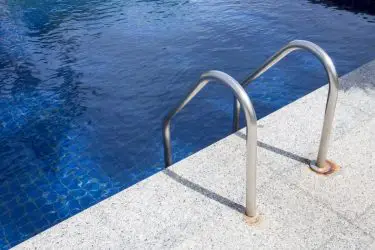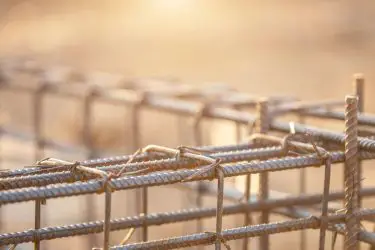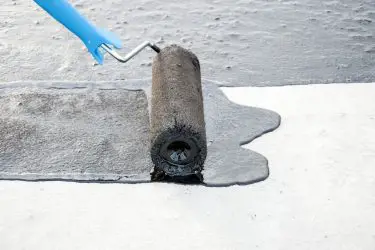Pavers and concrete are two of the most common materials you can use to spruce up your patio, walkway, or driveway. But since each material has unique strengths and weaknesses, choosing between pavers and concrete is easier said than done, especially for those of us who aren’t well versed in the fine details of home improvement. If you’re facing this dilemma, there are a few things you’ll want to keep in mind.
Standard concrete is cheaper upfront and easier to maintain than pavers. However, it’s more expensive long term because repairs are more frequent, complex, and costly. It’s also less durable and doesn’t add as much curb appeal and value to a property as pavers.
In the rest of this post, we’ll compare pavers to concrete based on factors such as cost, maintenance, repairs, durability, impact resistance, safety, and many more to help you choose the most suitable material for your paving project. Let’s dive right in!

Table of Contents
Pavers vs. Concrete: Maintenance
The ease of maintenance is always an important consideration when choosing construction material for outdoor updates. With all other factors held constant, you should always choose a material that won’t make your driveway, patio, or walkway a hassle to keep in good shape.
Concrete Maintenance
Generally, concrete is easier to maintain than pavers, even though it’s not immune to cracking and staining with time.
Minor stains on stamped concrete can be power washed or rinsed off with a scrub brush and conventional soap.
Also, you can always apply protective sealants to help keep stains at bay. Small cracks are easy to patch up too, but they likely won’t appear until the concrete starts to age.
Pavers Maintenance
While pavers aren’t the hardest driveway, patio, or walkway surface to clean, they are slightly more difficult to clean than concrete because they aren’t a single slab.
Additionally, weeds are a more significant concern with pavers due to the numerous joints between the stones. Polymer sand may be added to interlock the pavers, but some relentless weeds may still grow. As such, you’ll be doing more weed control with pavers than concrete.
Pavers vs. Concrete: Durability
Pavers outperform concrete when it comes to durability, especially in areas that experience extreme temperature fluctuations and ground movement. Concrete slabs aren’t as great as pavers at handling either situation.
Concrete Durability
The contraction and expansion caused by frequent changes in soil temperature can cause cracks on concrete, and so can ground movement. If ground movement causes the slabs to shift too much, you may start to experience drainage issues with concrete.
On average, standard concrete slabs last 25 years. This period may vary with the installation process, the climate, and materials used.
Pavers Durability
Thanks to their interlocking system, pavers are better at withstanding temperature fluctuations and ground movement. The joints between each piece allow the surface to adjust to the minor movement caused by ground shifting, helping prevent cracks. They also help keep the surface flexible and disperse any weight exerted on it more evenly, further helping keep cracks at bay.
And since the joints don’t let water stagnate on the surfaces, pavers are less prone to drainage issues than concrete. As long as your installation is appropriately graded, you should never experience any drainage issues with pavers.
Lastly, properly installed pavers have a better load-bearing capacity than concrete. They can handle four times more weight than concrete, meaning they’re four times less to break when you drive a heavily loaded vehicle over.
This is probably why most manufacturers have no problem backing up their paving stone products with a Lifetime Guarantee against cracking and breaking. On average, pavers can last more than 50 years, depending on the type, how well they’re installed, and how well you take care of the surface.
Pavers vs. Concrete: Ease of Installation
Both pavers and concrete have labor-intensive installation. The installation processes for both options involve many steps and don’t room much room for error.
Even the smallest of mistakes can have dire consequences, so you’ll want to have a professional do the installation unless you’re more skilled than the average DIYer in this kind of construction.
Concrete
With that said, the installation process for concrete is slightly less labor-intensive than that of pavers. It involves five steps: excavation, grading, foundation preparation, setting forms, pouring the concrete, and letting it dry and cure for a couple of days before using.
Read more: How To Pour a Concrete Slab: The Ultimate DIY Guide
Pavers
On the other hand, installing paving stones can be a more complicated process that takes longer than concrete. The exact procedure may vary slightly with the specific type of pavers.
For illustration, we’ll choose natural stone pavers. The installation process for this type of pavers involves the following steps:
- Excavation
- Grading
- Sub-base compaction
- Installing geotextile fiber
- Base preparation
- Base compaction
- Sand preparation
- Laying the pavers
- Cutting the borders
- Bond beam preparation
- Compacting the stones
- Sealing the pavers
Notably, there are way more steps involved with pavers than concrete. On the bright side, pavers don’t require time to cure, so you can use them as soon as the sealant dries off.
Pavers vs. Concrete: Cost
To determine how much you’ll spend if you decide to spruce up your patio, driveway, or walkway with each material, you need to have a rough idea of both the purchase price and installation costs associated with both pavers and concrete.
This way, you can compare the total cost for both options instead of tackling the installation and purchase costs separately. It’s precisely why we didn’t cover installation costs in the previous section.
Concrete Much Does Concrete Cost
Generally, concrete is cheaper than pavers upfront. Depending on who does the installation and what type it is, you may pay about $6-$10 per square foot.
If it’s a simple concrete slab installation without texturing/stamping, what you spend will lean more to the lower end of this range.
And if you DIY, you’ll spend even less, with concrete costing about $1.5 per square foot. Keep in mind that if your concrete supplier has a minimum order policy, you may end up purchasing more concrete than you need for your project.
It’s worth noting that while concrete is cheaper upfront, it’s potentially expensive in the long run.
Since it’s less durable, repairs may be more common on a concrete driveway, patio, or walkway than one made of pavers. Repairs can get costly, so you might want to consider the potential long-term costs before you outrightly brand concrete as the cheaper option.
Read our article ‘Cost of a Yard of Concrete (With 35+ real examples)‘ for more details and real cost examples from different parts of the country.
How Much Does Pavers Cost
On the other hand, pavers’ total cost may run as high as $10-$20 per square foot. Because installation is typically labor-intensive, it accounts for a more significant chunk of the total cost.
That’s why you may end up paying $20 per square foot when the pavers themselves cost only half that price.
A single brick costs $0.50 to $5.00 per square foot, and you need two to cover one square foot. Flagstone pavers are even more expensive, with DIY costs ranging from $15 to $20 per square foot.
Also Read: Pavers vs. Stamped Concrete: Ultimate Price Comparison
Pavers vs. Concrete: Aesthetic Appeal
Anyone who has ever seen surfaces made of both materials will admit that pavers are more attractive than ordinary concrete. They come in various sizes, colors, patterns, and styles, giving you more customization possibilities. But there is a way to make concrete look fantastic…
Concretes’ Aesthetic Appel
Even though conventional concrete isn’t too aesthetically pleasing, manufacturers are now providing an upgraded option that you might want to consider: stamped concrete.
This type of concrete comes with a design that’s stamped on the surface for a more attractive look than plain concrete. You can get all kinds of patterns, and your concrete can even look like wood!
Just look at these 11 Good-Looking Stamp Patterns to know what I’m talking about!
Stamped concrete can also be tinted/stained for a more dynamic look and is less susceptible to stains and cracks. As you’d expect, these benefits mean a higher price than conventional concrete.
Pavers‘ Aesthetic Appel
Pavers are normally less prone to fading because their color is usually ingrained deeply into the material, making them an ideal long-term solution for areas that experience lots of traffic, like sidewalks and driveways.
Pavers vs. Concrete: Safety
There isn’t much of a difference in how safe it is to have concrete or pavers installed at your home. There are always risks working with construction though.
Concrete
Concrete slabs can get slippery when it rains, causing all kinds of problems.
A slippery driveway can compromise your vehicle’s traction, which can lead to skid marks and increase the risk of accidents. A slippery deck or patio can be equally hazardous, especially if you or your loved ones take a hard fall on the concrete.
Fortunately, there are simple ways to make sure that the concrete gets a non-slip surface as well.
But if you are going to work with concrete yourself, it might be a good idea to check out these articles before proceeding:
Pavers
By design, pavers are non-slip and non-skid. That gives vehicles better traction to help avoid unsightly tire marks and reduce the risk of slip-caused accidents on a rained-on deck or patio.
So in terms of general safety, pavers are just as good as concrete.
Pavers vs. Concrete: Value
As a homeowner, you want any installation and home improvements you invest in to translate to higher property value. Even if you’re not looking to sell, you can benefit from higher property value in many other ways, like qualifying for more favorable loans.
And because upgrading your patio, deck or driveway is always a significant investment, you want to use a material that adds the most value to your property.
Generally, pavers add more value to a home than concrete. It’s easy to see why, too, given that pavers are often more visually appealing, more expensive, and longer-lasting than concrete. So if bumping up your home’s resale value is a priority, pavers are the way to go.
Pavers vs. Concrete: Impact Resistance
Properly installed concrete slabs are strong and can resist a substantial amount of surface impact.
However, pavers are even stronger and more impact-resistant, meaning they can hold more weight without cracking.
While the impact resistance varies with the type of pavers used, most options can withstand up to 8000 PSI.
On the other hand, concrete slabs can only support up to 2500 PSI. Thus, they’re more prone to cracking under excess vehicle and foot traffic than pavers.
Pavers vs. Concrete: Ease and Cost of Repairs
Pavers are easier and cheaper to repair than concrete. When a concrete slab sustains significant damage, you’ll need to remove the entire slab before having new concrete poured, which can be costly if a large area has sustained damage.
Related Article: Pouring New Concrete over Cracked Concrete
You can patch up minor cracks, but this will likely leave behind unsightly mismatched coloring on the surface.
Alternatively, you can hire a professional to resurface the concrete, which can be costly. Of course, If you’re handy, you can resurface your concrete driveway (or whatever) by yourself to save some money.
Since pavers are made up of individual interlocking units, it’s easier to remove and replace only the damaged piece.
This is easier and less costly than removing and replacing an entire concrete slab. Additionally, replaced stones won’t look any different from the rest of the surface, meaning you won’t be left with an unevenly colored pavement.
With the ease of repairs covered, let’s shift our attention to the repair costs associated with each option.
How Much Does Concrete Cost To Repair?
The cost of patching up holes and cracks on concrete depends on the affected area’s size, whether you’re hiring a professional or doing it yourself, and whether you need to remove the whole slab or just patch it up.
Cracks and holes are reasonably simple to fill by yourself as long as you don’t mind getting your hands dirty and can follow the handful of instructions detailed in this video:
There are a lot of different concrete fillers out there, which means it can be hard to choose which one to buy. To help you choose the best one for your situation, we wrote the article ‘10 Best Concrete Crack Fillers for Driveways (Buyer’s Guide)‘.
If you choose the DIY route, expect to spend about $100. Of course, this figure may vary with the number of supplies required, which depends on the affected area’s size. If you choose to hire a professional, set aside an extra $300 to cover their fees.
And if your driveway requires significant repairs, where the concrete has cracked, sunk, or needs replacement, expect to spend up to $20 per square foot. This figure may even run higher depending on the extent of the damage and type of material.
Resurfacing is a bit cheaper, with costs ranging from $3 to $10 per square foot, depending on the type of resurfacing you want and the existing concrete’s condition.
How Much Do Pavers Cost To Repair?
The most common problem with pavers is having one or several stones/bricks break. Depending on the type of pavers you opt for, you may be able to do the repairs without hiring a professional.
If you opt for brick set in mortar, you’ll need to hire a stonemason for about $75 an hour (may vary with location and professional).
Concrete and brick pavers that don’t have artistic features are less complicated to repair, so you can DIY. A DIY fix will only set you back by the cost of materials: $0.5 per paver plus the cost of required tools and materials.
Here’s a quick video on how to repair pavers:
Pavers vs. Concrete: Which Is Better?
If you’ve been following our discussion closely, you probably know the answer to this question already. But just in case you drifted off (it’s understandable; we’ve covered quite the ground), let’s try to pick an outright winner between pavers and concrete using the table below:
| Standard Concrete | Pavers | |
| Cost per Square Foot | $6-$10 | $10-$20 |
| Appearance | Simple & standard | Customizable |
| Durability | May develop cracks over time | Supports weight |
| Maintenance | Easy | More complex |
| Repairs | Complex | Simple |
| Length of Life | 25+ years | 50+ years |
| Slip Resistance | Good with coating | Typically good |
| Increase in Property value after installation | Low | High |
As you can see, pavers outperform concrete on most merits. So if we were to pick an outright winner between the two paving materials, it would be pavers. But that doesn’t make pavers universally a better choice because every homeowner’s needs are different.
What all this means is that might be better off choosing:
- Pavers if you don’t mind spending more upfront to enjoy more durability, slip resistance, increase in property value, simple repairs, and customizable curb appeal.
- Standard concrete if you can’t afford pavers and don’t mind a shorter service life, frequent repairs, and having to apply a coating to improve slip resistance if all this means spending less upfront. The keyword here is standard because stamped concrete costs just about the same as paving stones. In some locations, stamped concrete is even more expensive than some types of pavers.
Let’s talk a bit more about stamped concrete to inform your decision further.
Despite being priced higher, this type of concrete comes with pretty much the same issues as standard concrete in terms of cracking and staining.
The difference is that it’s better looking because it can be textured to resemble brick, wood, or flagstone.
This decorative aspect is primarily why stamped concrete is considered an upgrade to standard concrete and priced as such. It improves a home’s curb appeal by adding style to the outdoors and might even boost property value if you get your selection right.
Final Remarks
That does it for today’s discussion. Hopefully, this in-depth comparison of pavers and concrete has helped you make up your mind regarding which type of material to use on your patio, driveway, or walkways. Again, make this decision based on your priorities.
Every homeowner has different preferences and financial capability and places varying levels of priority on things like style, maintenance, durability, cost, and increasing property value.



